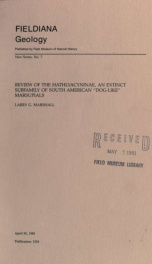Review of the Hathlyacyninae, an extinct subfamily of South American "dog-like" marsupials Fieldiana, Geology, new series, no. 7

Members of the extinct "dog-like" marsupial subfamily HATHLYACYNINAE (Borhyaenidae, Borhyaenoidea) are known from beds of Late Paleocene (Riochican) through Pliocene (Montehermosan) age in Argentina and beds of early Oligocene (Deseadan) age in Bolivia. Twelve genera and 18 species are recognized: Patene simpsoni Paula Couto, 1952; Patene coluapiensis Simpson, 1935; Procladosictis anomala Ameghino, 1902; Pseudonotictis pusillus (Ameghino, 1891) gen. nov.; Notictis ortizi Ameghino, 1889; Perathereutes pungens Ameghino, 1891; Borhyaenidium musteloides Pascual & Bocchino, 1963; Borhyaenidium riggsi sp. nov.; Sipalocyon externa (Ameghino, 1902); Sipalocyon gracilis Ameghino, 1887; Sipalocyon obusta (Ameghino, 1891); Notocynus hermosicus Mercerat, 1891; Notogale mitis (Ameghino, 1897); Cladosictis centralis Ameghino, 1902; Cladosictis patagonica Ameghino, 1887; Chasicostylus castroi Reig, 1957; Anatherium herrerae sp. nov.; and Anatherium defossus Ameghino, 1887. In addition, Procladosictis erecta Ameghino, 1902; Pseudocladosictis determinabile Ameghino, 1902; and Notogale tenuis (Ameghino, 1897) are regarded as nomina vana. -- The species and genera are distinguished largely on the basis of absolute and relative size differences in the dentition. Such characters as presence or absence of a metaconid; relative size of protocone, talonid, and stylar shelf; spacing differences between C, P1, and P2; and orientation of P1 in the jaw relative to other cheek teeth also proved useful in distinguishing these taxa. -- With regard to dental structure and incisor number, hathlyacynes are the most generalized of known borhyaenids, and early members (i.e., Patene) closely approximate the expected condition of their presumed didelphoid ancestors. The general evolutionary trend within the Hathlyacyninae involved increase in carnassial specializations resulting in loss of metaconid and reduction in size of protocone, stylar shelf, and talonid. The group has been extremely conservative during its evolutionary history, and structurally the taxa are monotonously alike. Nevertheless, if sheer numbers of individuals and taxa are a gauge, then the Hathlyacyninae was the most successful of the borhyaenid subfamilies Includes bibliographical references (p. 117-120) Members of the extinct "dog-like" marsupial subfamily HATHLYACYNINAE (Borhyaenidae, Borhyaenoidea) are known from beds of Late Paleocene (Riochican) through Pliocene (Montehermosan) age in Argentina and beds of early Oligocene (Deseadan) age in Bolivia. Twelve genera and 18 species are recognized: Patene simpsoni Paula Couto, 1952; Patene coluapiensis Simpson, 1935; Procladosictis anomala Ameghino, 1902; Pseudonotictis pusillus (Ameghino, 1891) gen. nov.; Notictis ortizi Ameghino, 1889; Perathereutes pungens Ameghino, 1891; Borhyaenidium musteloides Pascual & Bocchino, 1963; Borhyaenidium riggsi sp. nov.; Sipalocyon externa (Ameghino, 1902); Sipalocyon gracilis Ameghino, 1887; Sipalocyon obusta (Ameghino, 1891); Notocynus hermosicus Mercerat, 1891; Notogale mitis (Ameghino, 1897); Cladosictis centralis Ameghino, 1902; Cladosictis patagonica Ameghino, 1887; Chasicostylus castroi Reig, 1957; Anatherium herrerae sp. nov.; and Anatherium defossus Ameghino, 1887. In addition, Procladosictis erecta Ameghino, 1902; Pseudocladosictis determinabile Ameghino, 1902; and Notogale tenuis (Ameghino, 1897) are regarded as nomina vana. -- The species and genera are distinguished largely on the basis of absolute and relative size differences in the dentition. Such characters as presence or absence of a metaconid; relative size of protocone, talonid, and stylar shelf; spacing differences between C, P1, and P2; and orientation of P1 in the jaw relative to other cheek teeth also proved useful in distinguishing these taxa. -- With regard to dental structure and incisor number, hathlyacynes are the most generalized of known borhyaenids, and early members (i.e., Patene) closely approximate the expected condition of their presumed didelphoid ancestors. The general evolutionary trend within the Hathlyacyninae involved increase in carnassial specializations resulting in loss of metaconid and reduction in size of protocone, stylar shelf, and talonid. The group has been extremely conservative during its evolutionary history, and structurally the taxa are monotonously alike. Nevertheless, if sheer numbers of individuals and taxa are a gauge, then the Hathlyacyninae was the most successful of the borhyaenid subfamilies Fieldiana series has been published as Geological Series by Field Columbian Museum (1895-1909) and Field Museum of Natural History (1909-1943), and as Fieldiana: Geology by Chicago Natural History Museum (1945-1966) and Field Museum of Natural History (1966-1978). Fieldiana Geology New Series No. 1 began June 29, 1979
Info about the book
Author:
Series:
Unknown
ISBN:
0801884721
Rating:
3/5 (3)Your rating:
0/5
Languge:
English
Users who have this book
Users who want this book
What readers are saying
What do you think? Write your own comment on this book!
write a commentif you like Review of the Hathlyacyninae, an extinct subfamily of South American "dog-like" marsupials Fieldiana, Geology, new series, no. 7 try:
Other books by this author
Do you want to exchange books? It’s EASY!
Get registered and find other users who want to give their favourite books to good hands!









